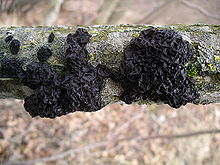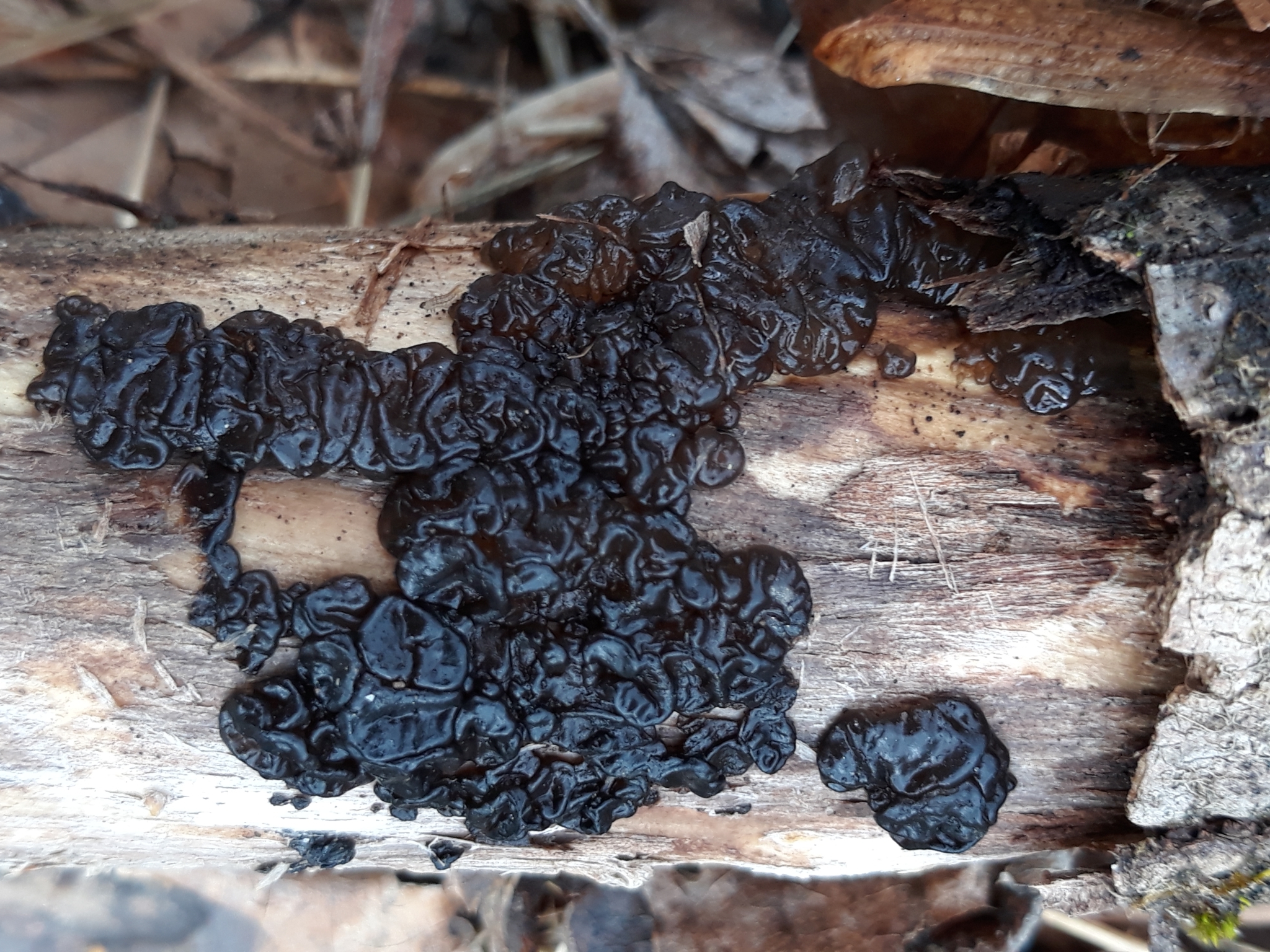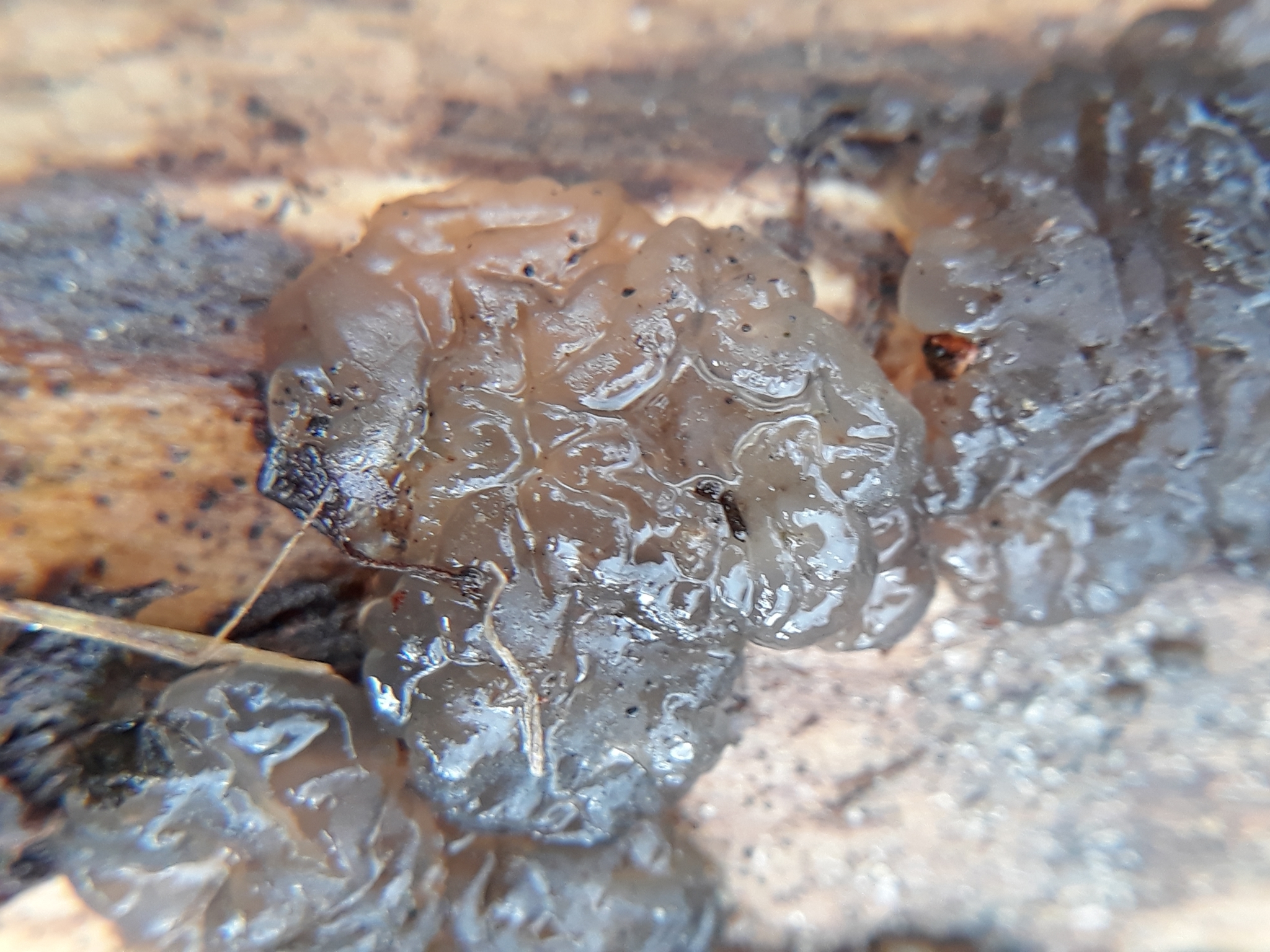Map Snapshot










18 Records
Seasonality Snapshot
Source: Wikipedia
| Exidia nigricans | |
|---|---|

| |
| Exidia nigricans | |
| Scientific classification | |
| Domain: | Eukaryota |
| Kingdom: | Fungi |
| Division: | Basidiomycota |
| Class: | Agaricomycetes |
| Order: | Auriculariales |
| Family: | Auriculariaceae |
| Genus: | Exidia |
| Species: | E. nigricans
|
| Binomial name | |
| Exidia nigricans (With.) P. Roberts (2009)
| |
| Synonyms | |
|
Tremella nigricans With. (1776) | |
Exidia nigricans is a species of fungus in the family Auriculariaceae. In the UK, it has the recommended English name of warlock's butter.[1] It produces black, gelatinous basidiocarps (fruit bodies) and is a common, wood-rotting species throughout the Northern Hemisphere, typically growing on dead attached branches of broadleaf trees. It has been much confused with Exidia glandulosa.
Taxonomy
[edit]The species was originally described from England as Tremella nigricans by Withering in 1776, based on a phrase name published by Dillenius in 1741. It was subsequently considered a synonym of Exidia glandulosa, until Donk revised species concepts in 1966 and placed it in synonymy with E. plana.[2] Changes in the starting point for fungal nomenclature[3] delegitimized E. plana, making E. nigricans the species' earliest name.[4]
Molecular research has shown that E. nigricans has distinct DNA from E. glandulosa, despite similarities, even on a microscopic level.[5]
Common name
[edit]Both Dillenius (1741) and Withering (1776) gave the English name for this species as "Witches' butter",[4] though this name has subsequently also been applied to other gelatinous fungi, including E. glandulosa and the yellow Tremella mesenterica. It is said to be based on a folk belief that witches milk cows at night and scatter the butter they create in the process around.
Description
[edit]Exidia nigricans forms dark sepia to blackish, rubbery-gelatinous fruit bodies that are button-shaped and 1–2 centimetres (1⁄2–3⁄4 inch) across. The fruitbodies occur in clusters and quickly coalesce to form effused, irregular masses up to 20 cm (8 in) across.[6] The upper, spore-bearing surface is shiny and dotted with small pimples or pegs. The individual fruitbodies are each attached to the wood at the base. The spore print is white.[7]
Microscopic characters
[edit]
The microscopic characters are typical of the genus Exidia. The basidia are ellipsoid, septate, 15–25 × 8–13 μm. The spores are allantoid (sausage-shaped), 14–19 × 4.5–5.5 μm.[7]
Similar species
[edit]
Exidia nigricans and E. glandulosa are frequently confused. The two are similar (even microscopically), but E. glandulosa produces discrete, top-shaped fruitbodies that rarely if ever coalesce.[5]
Fruitbodies of Phaeotremella foliacea and P. frondosa are typically a warmer, lighter brown, but can sometimes be dark sepia to black. The fruitbodies are gelatinous, but usually foliaceous (with flattish lobes or fronds) and never have warts or pegs on the surface.[8] Non-gelatinous, black fruit bodies on wood occur in other genera, including Annulohypoxylon, Biscogniauxia, Camarops, and Hypoxylon.[6]
Habitat and distribution
[edit]Exidia nigricans is a wood-rotting species, typically found on dead attached branches of a wide range of broadleaf trees. It persists for some while on fallen branches and logs. The species typically fruits in autumn and winter. It is widely distributed in the Northern Hemisphere, including Europe and North America. In the latter, it can be found from November to March on the west coast, and around the year elsewhere.[6]
References
[edit]- ^ Holden L. (2024). "English names for fungi". British Mycological Society. Retrieved 15 August 2024.
- ^ Donk, M.A. (1966). Check list of European hymenomycetous heterobasidiae. Persoonia 4: 145–335.
- ^ International code for botanical nomenclature http://ibot.sav.sk/icbn/main.htm
- ^ a b Roberts, P. (2009). Exidia nigricans: a new and legitimate name for Exidia plana. Mycotaxon 109: 219–220.
- ^ a b Weiss, M & Oberwinkler, F. (2001). Phylogenetic relationships in Auriculariales and related groups – hypotheses derived from nuclear ribosomal DNA sequences. Mycological Research 105: 403–415.
- ^ a b c Audubon (2023). Mushrooms of North America. Knopf. p. 111. ISBN 978-0-593-31998-7.
- ^ a b Breitenbach, J. & Kranzlin, F. (1986). Fungi of Switzerland Vol. 2: 65 (as E. glandulosa)
- ^ Spirin V, Malysheva V, Yurkov A, Miettinen O, Larsson KH (2018). "Studies in the Phaeotremella foliacea group (Tremellomycetes, Basidiomycota)". Mycological Progress. 17 (4): 451–466. doi:10.1007/s11557-017-1371-4. hdl:10138/326186. S2CID 44901453.

